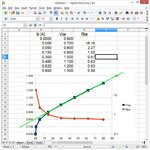eng_boody
Member level 3

- Joined
- Nov 27, 2011
- Messages
- 57
- Helped
- 1
- Reputation
- 2
- Reaction score
- 1
- Trophy points
- 1,288
- Activity points
- 1,754
hi all,
First Question
---------------
In the hFE-IC curve it's plotted at logarithmic scale (both axis) assuming i can print the graph and measure distances on paper accurately using a vernier caliper how can i convert distances to linear values (in details please step by step)
Second Question
------------------
Assuming I Could read the hFE-IC curve and convert it into linear scale, the problem it's specified at 4 volts ... how can i obtain such a curve at 5 volts not 4 volts.
Third Question
---------------
Assuming I will force VCE at 5 volts using a 5volts Regulator to measure VBE-IB curve at 5 volts ...and plot a graph (curve fitting) and get equation for that, the problem is that my lm7805 doesn't supply regulate voltage, it fluctuates +- 0.3 (too large), how could get a very stable 5 volt power supply knowing that am using a transformer and bridge not battery how to solve this problem,
thanks in advance , I appreciate all ur comments and replys
First Question
---------------
In the hFE-IC curve it's plotted at logarithmic scale (both axis) assuming i can print the graph and measure distances on paper accurately using a vernier caliper how can i convert distances to linear values (in details please step by step)
Second Question
------------------
Assuming I Could read the hFE-IC curve and convert it into linear scale, the problem it's specified at 4 volts ... how can i obtain such a curve at 5 volts not 4 volts.
Third Question
---------------
Assuming I will force VCE at 5 volts using a 5volts Regulator to measure VBE-IB curve at 5 volts ...and plot a graph (curve fitting) and get equation for that, the problem is that my lm7805 doesn't supply regulate voltage, it fluctuates +- 0.3 (too large), how could get a very stable 5 volt power supply knowing that am using a transformer and bridge not battery how to solve this problem,
thanks in advance , I appreciate all ur comments and replys



